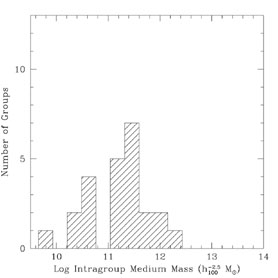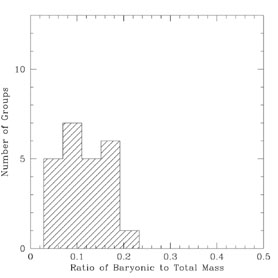Copyright © 2000 by Annual Reviews. All rights reserved
| Annu. Rev. Astron. Astrophys. 2000. 38: 289-335
Copyright © 2000 by Annual Reviews. All rights reserved |
5.3. Baryon Fraction
The ratio of baryonic to total mass in groups and clusters can provide
interesting constraints on cosmological models (e.g.
Walker et al 1991,
White et al 1993).
The two known baryonic components in groups are the galaxies and the hot
gas. The total mass in galaxies can be estimated by measuring the total
galaxy light and assuming an appropriate mass-to-light ratio for each
galaxy based on its morphological type. While ideally the luminosity
function of each group should be used to measure the total light,
generally most authors have included only the contribution of the most
luminous galaxies. Fortunately, these galaxies account for nearly all
the light in the group. The mass-to-light ratios of X-ray groups are
generally in the range M / LB ~ 120-200 h100
M /
L
/
L (Mulchaey et al
1996a),
which is comparable to the mass-to-light ratios found in rich
clusters. However, these estimates are made out to the radius of X-ray
detection, so the values out to the virial radius could be
larger. Assuming standard mass-to-light ratios for ellipticals and
spirals, the mass in galaxies in X-ray groups is typically in the range
3 × 1011-2 × 1012
h-1100
M
(Mulchaey et al
1996a),
which is comparable to the mass-to-light ratios found in rich
clusters. However, these estimates are made out to the radius of X-ray
detection, so the values out to the virial radius could be
larger. Assuming standard mass-to-light ratios for ellipticals and
spirals, the mass in galaxies in X-ray groups is typically in the range
3 × 1011-2 × 1012
h-1100
M (Figure 9).
(Figure 9).
 |
Figure 9. Distribution of galaxy mass for the sample of groups used in Figure 8. |
The mass in the intragroup medium can be estimated from the model fit to
the surface brightness profile. The gas-mass estimates depend both on
the radius out to which X-rays are detected
(Henriksen & Mamon
1994)
and on the spectral properties assumed (for example, the gas
metallicity;
Pildis et al 1995).
For these reasons, different authors have derived significantly
different gas masses for the same systems (cf
Mulchaey et al
1996a).
For most groups, the gas mass is in the range ~ 2 ×
1010-1012 h100-5/2
M (Figure 10). This is somewhat less than or
comparable to the mass in galaxies. Note, however, that the gas mass is
much more strongly dependent on Ho, and for more realistic
(i.e. lower) values of Ho, the gas mass can be somewhat
higher than the galaxy mass. The observed gas mass-to-stellar mass ratio
tends to decrease as the temperature of the system decreases. This trend
extends from rich clusters to individual elliptical galaxies.
David et al (1995)
estimate that the gas-to-total mass fraction is approximately 2% in
ellipticals, 10% in groups and 20-30% in rich clusters. However, the hot
gas in groups is detected to a much smaller fraction of the virial
radius than in rich clusters, so comparisons made at the current level
of X-ray detection may not accurately reflect the global gas fractions
(Loewenstein
2000). In fact, much of the intragroup gas probably lies beyond the
current X-ray detection limits, and on more global scales, groups may
not be gas-poor compared to clusters. Consequently, the total gas masses
of groups may be severely underestimated by ROSAT observations. On
scales of the virial radius, the intragroup medium is likely the
dominant baryonic component in these systems. In fact,
Fukugita et al
(1998)
estimated that diffuse gas in groups is the dominant baryon component in
the nearby universe. A fundamental assumption in Fukugita et al's
calculation is that all groups contain an intragroup medium and that the
absence of X-ray detections in many groups is primarily a result of
lower virial temperature rather than the absence of plasma. Regardless
of whether this assumption is valid or not, it is now clear that
intragroup gas is an important baryonic constituent of the local
universe.
(Figure 10). This is somewhat less than or
comparable to the mass in galaxies. Note, however, that the gas mass is
much more strongly dependent on Ho, and for more realistic
(i.e. lower) values of Ho, the gas mass can be somewhat
higher than the galaxy mass. The observed gas mass-to-stellar mass ratio
tends to decrease as the temperature of the system decreases. This trend
extends from rich clusters to individual elliptical galaxies.
David et al (1995)
estimate that the gas-to-total mass fraction is approximately 2% in
ellipticals, 10% in groups and 20-30% in rich clusters. However, the hot
gas in groups is detected to a much smaller fraction of the virial
radius than in rich clusters, so comparisons made at the current level
of X-ray detection may not accurately reflect the global gas fractions
(Loewenstein
2000). In fact, much of the intragroup gas probably lies beyond the
current X-ray detection limits, and on more global scales, groups may
not be gas-poor compared to clusters. Consequently, the total gas masses
of groups may be severely underestimated by ROSAT observations. On
scales of the virial radius, the intragroup medium is likely the
dominant baryonic component in these systems. In fact,
Fukugita et al
(1998)
estimated that diffuse gas in groups is the dominant baryon component in
the nearby universe. A fundamental assumption in Fukugita et al's
calculation is that all groups contain an intragroup medium and that the
absence of X-ray detections in many groups is primarily a result of
lower virial temperature rather than the absence of plasma. Regardless
of whether this assumption is valid or not, it is now clear that
intragroup gas is an important baryonic constituent of the local
universe.
 |
Figure 10. Distribution of intragroup medium mass for the sample of groups used in Figure 8. |
Adding up the baryons in galaxies and intragroup gas and comparing to
the total mass, one finds that the known baryonic components typically
account for only 10-20% of the total mass that is derived using the
X-ray data (Figure 11;
Mulchaey et al
1993;
Ponman & Bertram
1993;
David et al 1994;
Pildis et al 1995;
David et al 1995;
Doe et al 1995;
Davis et al 1995,
1996;
Mulchaey et al
1996a;
Pedersen et al
1997).
This provides some of the strongest evidence to date that small groups
of galaxies are dominated by dark matter. The ratio of mass in observed
baryonic components to total mass (i.e. the "baryon fraction") in
general is smaller in groups than in rich clusters
(David et al 1995,
David 1997).
However, the lower observed baryon fractions of groups may largely
reflect the fact that much of the hot gas occurs beyond the radius of
current X-ray detection. Even if the observed baryon fractions of groups
are representative of the global values, the baryon fractions in X-ray
groups are still too high to be consistent with the low baryon fractions
required for
 = 1 and standard
big bang nucleosynthesis (cf
White et al 1993).
= 1 and standard
big bang nucleosynthesis (cf
White et al 1993).
 |
Figure 11. Distribution of total observed baryonic mass to total group mass for the sample of groups used in Figure 8. The low "baryonic fractions" derived for groups indicate that these systems are dominated by dark matter. |